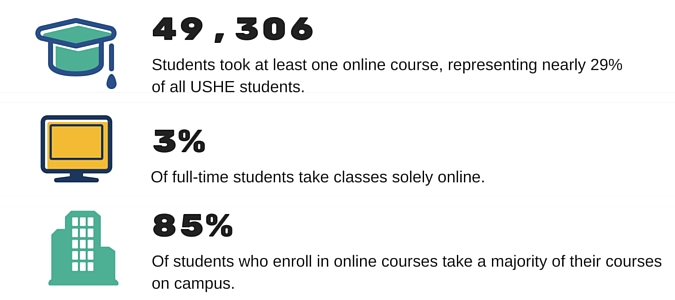Technology plays an increasingly important role in college students’ lives. Students use technology throughout their college education, from courses taught partially or entirely online, to registration, instructor evaluations, and tuition payments.
Completely online programs offered
USHE institutions now offer 1,738 fully online courses, 140 of which were added in the last year. There are also 84 programs completely online, including:
Online course-taking patterns
In Fall 2015, 49,306 students enrolled in colleges and universities in the Utah System of Higher Education (USHE) took at least one online course, which comes to nearly 29% of USHE students (headcount)—up from 18% only five years ago.
While the percent of students taking at least one online course has increased, less than 3% of full-time students take classes solely online. This pattern, which has remained consistent over several years, expresses USHE students’ preference for supplementing an on-campus schedule with one or two online courses. In fact, more than 85% of students who enroll in online courses take a majority of their courses on-campus. Most students who take classes solely online attend college part-time and are over 25 years old.
Other technology-delivered education
USHE students can take courses using technology in many ways. For instance, Interactive Video Conferencing (IVC) is an important delivery method for rural students. Also, hybrid classes, courses that are a mix of face-to-face and technology-delivered curriculum, show dramatic growth. NOTE: USHE began tracking hybrid courses in 2011.
*offer all GenEd courses required for a 4-year degree through a combination of IVC and online
Technology Intensive Concurrent Enrollment courses are designed to be hybrid, combining face-to-face and online learning activities. The goal of these courses is to provide high school juniors and seniors with the opportunity to earn college credit in general education and high demand career and technical education courses. To date, nine courses have been developed and an additional six courses are being piloted or are in development.
Highlights on technology usage at USHE institutions
- The University of Utah has provided students with flexible course scheduling options through online offerings since 2001. During the 2014-2015 academic year, 14,617 individual students accounted for 33,760 enrollments in 956 online sections. This indicates that 46% of University of Utah students enrolled in at least one online class during the year with many enrolling in two or more online classes. The majority of these students were on campus each week and used online offerings to fit needed classes into their schedules.
- Utah State University continues to use technology to improve flexibility, access, and affordability for an increasing number of students. From Fall 2014 to Fall 2015, USU’s online enrollments grew by 32% while the number of students in blended courses grew by over 100%. Additionally, online courses resulted in approximately 1,000 more students taking 15 or more credits, thus improving time to completion. For Summer term 2015, USU saw a 25% increase in overall headcount thanks in part to discounted tuition/fees and the availability of more online, blended, and face-to-face courses in a variety of schedules. In Fall 2015 alone there were 26,951 student using the Learning Management System Canvas, submitting 56,948 assignments and uploading 252,242 files –increasing from the previous year.
- Weber State University offered 237 courses that utilized a hybrid model replacing at least 20% of seat time, or one class period, with online instruction. Weber’s first Executive Graduate program, the eMHA degree, began in Fall 2015 with 17 students. In cooperation with the Accounting department at Dixie, the MTAX program was offered for the first time to students on their campus using IVC. Weber added an online BS degree in Professional Sales in direct response to local business needs.
- Southern Utah University is working to complete online BS degrees in Accountancy, Business Administration, and Communication. These programs should be available to students Fall 2016.
- Snow College – Alongside the significant increase in enrollment, Snow College has added 10 new fully-online courses this year, as well as six new IVC and seven new hybrid IVC (with pre-recorded lectures) courses. These IVC offering are being distributed through the concurrent enrollment program to the high schools in their service area. Over 65% of faculty are using Canvas and over 90% of students have one or more courses which utilize Canvas.
- Utah Valley University reorganized several departments within Academic Affairs to create a new Office of Teaching and Learning (OTL). The OTL has a mission to enable the enhancement of teaching and learning practice through meaningful faculty development, high-quality course design, and support for learning technologies. Online enrollments at UVU have increased by 4.61%, with an increase of 7.75% unique enrollments. Flexible learning courses (online, hybrid, and IVC) account for 22% of FTE enrollments. The OTL is collaborating across the Institution to launch several key initiatives in 2016, including competency based education, open education, condensed delivery, and to normalize hybrid delivery. Through the implementation of a new team-based course redesign methodology, the OTL has been able to support four times the level of flexible course development in its pilot semester (Fall 2015) than in the previous year.
- Salt Lake Community College – Online enrollment now accounts for approximately 20% of the annual FTE at SLCC, making SLCC Online (virtual campus) the second largest campus. SLCC Online offers over 200 online courses in 50 different disciplines. Strategic efforts are now being placed on program development and offerings. Development of a new Online General Education Certificate is underway, with plans to launch Fall 2016. Other online programs are also under development, including an AS in General Studies and AS in Business, targeted for Fall 2017. Additionally, SLCC is actively pursuing competency based education (CBE) in 20+ programs in our School of Applied Technology (SAT). Approximately 60% of all course sections are now using Canvas in some capacity, with an institutional push for increased Canvas use (syllabus, gradebook, student communication). Beginning in Fall 2016, students enrolled in two or more online courses or an online program, will be assigned a student success coach to provide them with the needed resources to meet their educational goals. Weekly meaningful contact will be made with each student by a student success coach through the first year (courses only) or program completion. Starfish Early Alert will soon be available within Canvas to help identify at-risk students.


